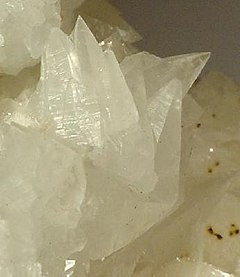Alstonite
| Alstonite | |
|---|---|

Alstonite crystals from Brownley Hill Mine, Alston Moor, Cumbria, England (size: 5.1 x 4.1 x 2.7 cm)
|
|
| General | |
| Category | Carbonate mineral |
|
Formula (repeating unit) |
BaCa(CO3)2 |
| Strunz classification | 5.AB.35 |
| Dana classification | 14.02.05.01 |
| Crystal system |
Triclinic Unknown space group |
| Unit cell | a = 17.38, b = 14.40 c = 6.123 [Å]; α = 90.35° β = 90.12°, γ = 120.08°; Z = 24 |
| Identification | |
| Formula mass | 297.42 g/mol |
| Colour | Colourless to snow-white; also pale gray, pale cream, pink to pale rose-red |
| Crystal habit | Steep pseudohexagonal dipyramids, pseudo-orthorhombic |
| Twinning | Common on pseudo-orthorhombic {110} and {310} |
| Cleavage | Imperfect on pseudo-orthorhombic {110} |
| Fracture | Uneven |
| Mohs scale hardness | 4 to 4.5 |
| Lustre | Vitreous |
| Streak | White |
| Diaphaneity | Transparent to translucent |
| Specific gravity | 3.70 |
| Optical properties | Biaxial (-) |
| Refractive index | nα = 1.526 nβ = 1.671 nγ = 1.672 |
| Birefringence | δ = 0.146 |
| 2V angle | Measured 6°, calculated 8° |
| Dispersion | Weak, r > v |
| Ultraviolet fluorescence | Weak yellow under LW and SW |
| Solubility | Soluble in dilute HCl |
| Alters to | Colour may fade on exposure to light |
| Other characteristics | Not radioactive |
| References | |
Alstonite, also known as bromlite, is a low temperature hydrothermal mineral that is a rare double carbonate of calcium and barium with the formula BaCa(CO3)2, sometimes with some strontium. and paralstonite have the same formula but different structures, so these three minerals are said to be trimorphous. Alstonite is triclinic but is monoclinic and paralstonite is trigonal. The species was named bromlite by T. Thomson in 1837, and alstonite by August Breithaupt of the Freiberg Mining Academy in 1841. Both of these names, derived from the locality, have been in common use.
Alstonite is triclinic, but appears pseudo-orthorhombic because of twinning. The space group is P1 or P1. Alstonite appears to have a superstructure based on paralstonite without long range order of the metal cations or the CO3 groups. The structure of paralstonite is similar to that of other double carbonates.
The number of formula units, Z, in the triclinic unit cell is given as 10 or 12, and the unit cell parameters are a = 17.38 Å, b = 14.40 Å, c = 6.123 Å, α = 90.35°, β = 90.12°, γ = 120.08°. The Handbook of Mineralogy, however, describes the mineral in terms of a pseudo-orthorhombic unit cell, with space group C1 or C1, Z = 24, and unit cell parameters a = 30.14 Å, b = 17.40 Å, c = 6.12 Å, α = β = γ = 90°.
...
Wikipedia
